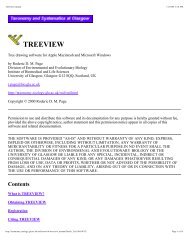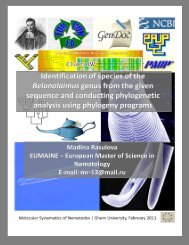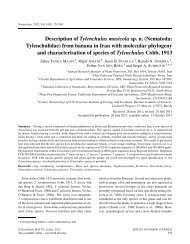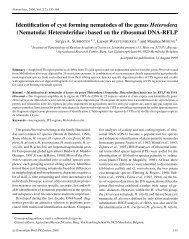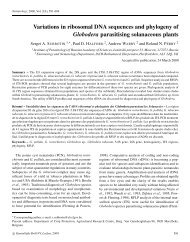Identification of the beet cyst nematode Heterodera schachtii by PCR
Identification of the beet cyst nematode Heterodera schachtii by PCR
Identification of the beet cyst nematode Heterodera schachtii by PCR
Create successful ePaper yourself
Turn your PDF publications into a flip-book with our unique Google optimized e-Paper software.
498<br />
RFLP pr<strong>of</strong>iles for several populations <strong>of</strong> this species<br />
(Szalanski et al., 1997; Subbotin et al., 2000).<br />
<strong>PCR</strong> with a species-specific primer can also be used<br />
successfully for species differentiation and constitutes<br />
a major step forward in developing DNA diagnostics.<br />
This approach allows to detect one or several <strong>nematode</strong><br />
species <strong>by</strong> using a single <strong>PCR</strong> test and decreases<br />
<strong>the</strong> diagnostic time and costs (Mulholland et al., 1996;<br />
Setterquist et al., 1996; Bulman and Marshall, 1997;<br />
Petersen et al., 1997; Williamson et al., 1997; Uehara<br />
et al., 1998; Zijlstra et al., 1995; Subbotin et al., 2001a).<br />
The objective <strong>of</strong> this work was to improve <strong>the</strong> identification<br />
<strong>of</strong> <strong>beet</strong> <strong>cyst</strong> <strong>nematode</strong> species with molecular<br />
methods. Therefore, we verified <strong>the</strong> applicability <strong>of</strong> <strong>the</strong><br />
<strong>PCR</strong>-RFLP diagnostic technique to a large collection<br />
<strong>of</strong> H. <strong>schachtii</strong> populations and tried to obtain RFLP<br />
diagnostic pr<strong>of</strong>iles for H. <strong>schachtii</strong>, H. betae, H. trifolii<br />
and H. medicaginis. We also report on <strong>the</strong> development<br />
<strong>of</strong> a rapid and precise method for <strong>the</strong> diagnosis <strong>of</strong> juveniles<br />
and <strong>cyst</strong>s <strong>of</strong> H. <strong>schachtii</strong> using a duplex <strong>PCR</strong> with<br />
a species-specific primer.<br />
Materials and methods<br />
Nematode populations<br />
Fifty-eight populations <strong>of</strong> different species <strong>of</strong> <strong>cyst</strong>forming<br />
<strong>nematode</strong>s were used in this study (Table 1).<br />
All H. <strong>schachtii</strong> populations, as well as two populations<br />
<strong>of</strong> H. betae (Münster, Germany; Berkane, Morocco),<br />
and one population <strong>of</strong> <strong>the</strong> clover <strong>cyst</strong> <strong>nematode</strong><br />
H. trifolii (New Zealand), Globodera rostochiensis,<br />
G. pallida and Pratylenchus penetrans were identified<br />
<strong>by</strong> <strong>the</strong>ir morphometrics and morphological characters.<br />
The remaining <strong>cyst</strong>-forming <strong>nematode</strong> species were<br />
previously identified based on <strong>the</strong>ir morphometrics and<br />
morphological characters and rDNA-RFLPs (Subbotin<br />
et al., 2000).<br />
Populations were maintained in pots kept in<br />
glasshouses or directly extracted from field soil samples.<br />
Cysts were extracted from <strong>the</strong> soil (Seinhorst,<br />
1964) and kept in Eppendorf tubes at room temperature<br />
during several weeks or months before use.<br />
Sample preparation for molecular studies<br />
Ei<strong>the</strong>r several <strong>cyst</strong>s, one <strong>cyst</strong>, or single juveniles<br />
alone or in a mixture with o<strong>the</strong>r <strong>nematode</strong> species<br />
were transferred into an Eppendorf tube containing<br />
8 µl distilled water and 10 µl <strong>nematode</strong> lysis<br />
buffer (500 mM KCl, 100 mM Tris–HCl pH 8.0,<br />
15 mM MgCl 2 , 1.0 mM DTT, 4.5% Tween 20) and<br />
crushed with an microhomogenisor Vibro Mixer<br />
(Zurich, Switzerland) for 2.5–3 min. Two microlitre<br />
proteinase K (600 µgml −1 ) (Promega Benelux, Leiden,<br />
The Ne<strong>the</strong>rlands) were added and <strong>the</strong> tubes were incubated<br />
at 65 ◦ C (1 h) and 95 ◦ C (10 min) consecutively<br />
and finally centrifuged (1 min; 16 000g). The DNA<br />
suspension was stored at −20 ◦ C and used for fur<strong>the</strong>r<br />
study.<br />
<strong>PCR</strong>-RFLP<br />
Ten microlitres <strong>of</strong> <strong>the</strong> DNA suspension were added to<br />
<strong>the</strong> <strong>PCR</strong> reaction mixture containing: 10 µl 10X Qiagen<br />
<strong>PCR</strong> buffer, 20 µl 5X Q-solution, 200 µM <strong>of</strong> each<br />
dNTP (Taq <strong>PCR</strong> Core Kit, Qiagen, Germany), 1.5 µM<br />
<strong>of</strong> each primer (syn<strong>the</strong>sised <strong>by</strong> Life Technologies,<br />
Merelbeke, Belgium), 0.8 U Taq Polymerase (5 U/µl)<br />
(Taq <strong>PCR</strong> Core Kit, Qiagen, Germany) and double distilled<br />
water to a final volume <strong>of</strong> 100 µl. Primers TW81<br />
and AB28 (Table 2, Figure 1) as described <strong>by</strong> Joyce<br />
et al. (1994) were used. The DNA-amplification pr<strong>of</strong>ile<br />
carried out in a GeneE (New Brunswick Scientific,<br />
Wezembeek-Oppem, Belgium) DNA <strong>the</strong>rmal cycler<br />
consisted <strong>of</strong> 4 min at 94 ◦ C; 35 cycles <strong>of</strong> 1 min at 94 ◦ C,<br />
Table 1. Species and populations <strong>of</strong> <strong>cyst</strong> <strong>nematode</strong>s tested in this study<br />
Species Population origin RFLPs <strong>PCR</strong> with<br />
specific primer<br />
<strong>Heterodera</strong> <strong>schachtii</strong> Molembaix, Belgium + +<br />
Hermé, Belgium + ∗ +<br />
Gingelon, Belgium + +<br />
Hérines, Warcoing, Belgium + +<br />
Quiévrain, Belgium + +<br />
Ohain, Belgium + +<br />
Meerdonk, Belgium − +<br />
Boire Glom, Belgium − +



